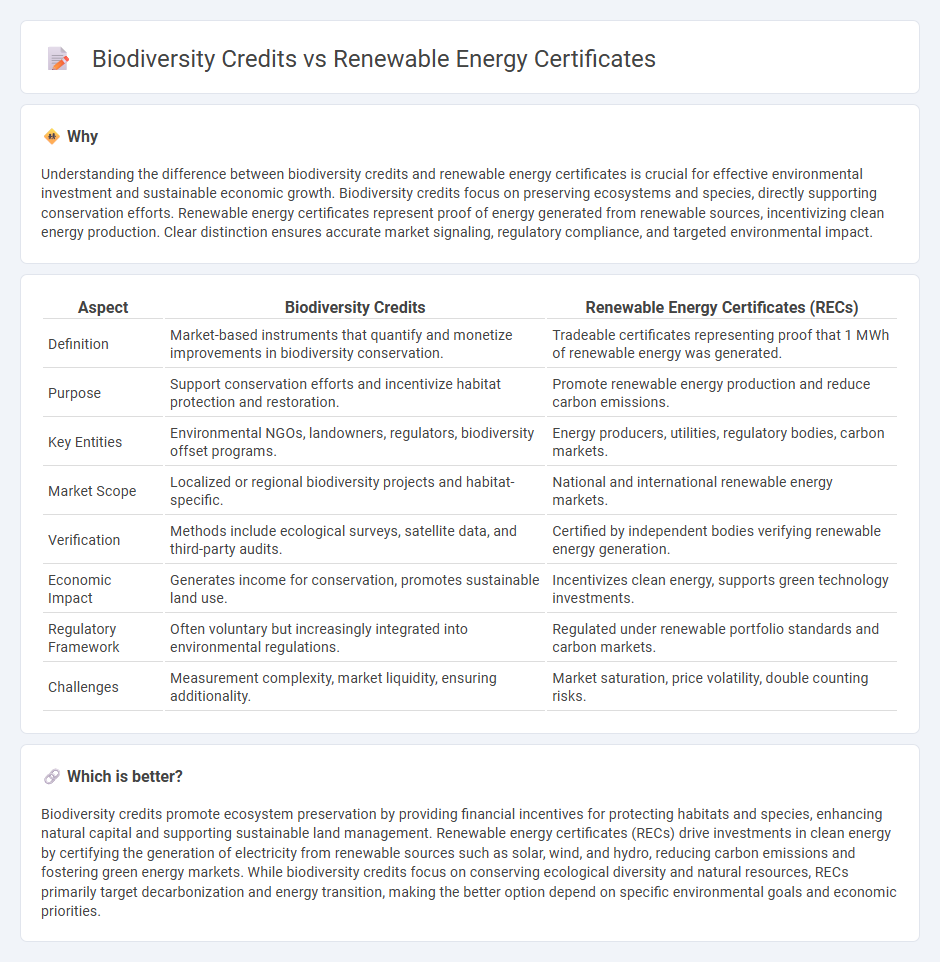
Biodiversity credits and renewable energy certificates are innovative market-based tools designed to promote environmental sustainability by attaching economic value to ecological benefits and clean energy production. Biodiversity credits focus on preserving ecosystems and species through conservation projects, while renewable energy certificates certify the generation of electricity from renewable sources like wind or solar, encouraging investment in green energy infrastructure. Explore the distinct roles and impacts of these instruments in driving eco-friendly economic growth.
Why it is important
Understanding the difference between biodiversity credits and renewable energy certificates is crucial for effective environmental investment and sustainable economic growth. Biodiversity credits focus on preserving ecosystems and species, directly supporting conservation efforts. Renewable energy certificates represent proof of energy generated from renewable sources, incentivizing clean energy production. Clear distinction ensures accurate market signaling, regulatory compliance, and targeted environmental impact.
Comparison Table
| Aspect | Biodiversity Credits | Renewable Energy Certificates (RECs) |
|---|---|---|
| Definition | Market-based instruments that quantify and monetize improvements in biodiversity conservation. | Tradeable certificates representing proof that 1 MWh of renewable energy was generated. |
| Purpose | Support conservation efforts and incentivize habitat protection and restoration. | Promote renewable energy production and reduce carbon emissions. |
| Key Entities | Environmental NGOs, landowners, regulators, biodiversity offset programs. | Energy producers, utilities, regulatory bodies, carbon markets. |
| Market Scope | Localized or regional biodiversity projects and habitat-specific. | National and international renewable energy markets. |
| Verification | Methods include ecological surveys, satellite data, and third-party audits. | Certified by independent bodies verifying renewable energy generation. |
| Economic Impact | Generates income for conservation, promotes sustainable land use. | Incentivizes clean energy, supports green technology investments. |
| Regulatory Framework | Often voluntary but increasingly integrated into environmental regulations. | Regulated under renewable portfolio standards and carbon markets. |
| Challenges | Measurement complexity, market liquidity, ensuring additionality. | Market saturation, price volatility, double counting risks. |
Which is better?
Biodiversity credits promote ecosystem preservation by providing financial incentives for protecting habitats and species, enhancing natural capital and supporting sustainable land management. Renewable energy certificates (RECs) drive investments in clean energy by certifying the generation of electricity from renewable sources such as solar, wind, and hydro, reducing carbon emissions and fostering green energy markets. While biodiversity credits focus on conserving ecological diversity and natural resources, RECs primarily target decarbonization and energy transition, making the better option depend on specific environmental goals and economic priorities.
Connection
Biodiversity credits and renewable energy certificates (RECs) both function as market-based mechanisms promoting environmental sustainability by assigning financial value to ecological benefits. Biodiversity credits incentivize the preservation of natural habitats and species, while RECs certify the generation of electricity from renewable sources, enabling corporate and governmental entities to meet environmental targets and reduce carbon footprints. Their connection lies in integrating ecosystem conservation with renewable energy adoption to achieve comprehensive climate and biodiversity goals.
Key Terms
Market-based instruments
Renewable Energy Certificates (RECs) quantify and trade the environmental benefits of electricity generated from renewable sources, incentivizing cleaner energy production through market-based mechanisms. Biodiversity credits represent tradable permits that fund conservation projects by assigning economic value to the preservation of ecosystems and species habitats, integrating ecological impacts into financial markets. Explore the nuances of these market-based instruments to understand their roles in advancing sustainable development.
Additionality
Renewable Energy Certificates (RECs) represent proof that one megawatt-hour of electricity was generated from a renewable energy resource, ensuring the displacement of fossil fuel-based energy and promoting additional renewable capacity in the grid. Biodiversity credits, on the other hand, quantify conservation outcomes that result in measurable, positive changes in ecosystems, with additionality assessed by the net gain in biodiversity compared to a baseline scenario without intervention. Explore further to understand how these credits drive environmental integrity and economic incentives in sustainability markets.
Trading mechanisms
Renewable energy certificates (RECs) are tradable commodities representing proof that one megawatt-hour of electricity was generated from renewable sources, facilitating compliance with renewable portfolio standards through market-based trading platforms. Biodiversity credits function similarly but are linked to quantifiable conservation outcomes, allowing companies to offset environmental impacts by purchasing credits tied to habitat preservation or restoration projects. Explore detailed comparisons and trading mechanisms to understand how these instruments drive sustainable environmental and energy markets.
Source and External Links
Renewable Energy Certificate (United States) - Renewable Energy Certificates (RECs) are tradable, non-tangible energy certificates representing proof that 1 megawatt-hour of electricity was generated from an eligible renewable energy source and fed into the grid, with markets divided into compliance and voluntary types based on regulatory requirements or consumer choice.
Renewable Energy Credits (RECs): What You Need To Know - RECs represent the clean energy attributes of renewable electricity, allowing buyers to claim the renewable aspect of the electricity generated, even though the physical electrons they use may come from the grid mix.
Renewable Energy Certificates (RECs) | US EPA - A REC is a market-based instrument representing the environmental, social, and other non-power attributes of 1 MWh of renewable electricity generation delivered to the grid, including detailed certificate information to authenticate and track renewable energy.
 dowidth.com
dowidth.com